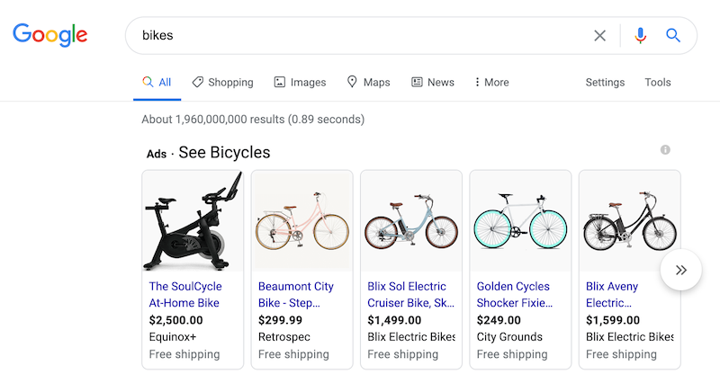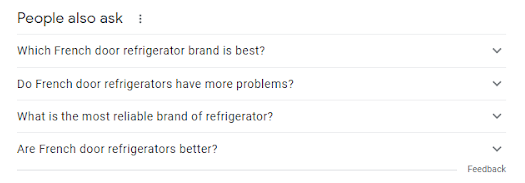Long-tail keywords are the breadwinners of the SEO world. Targeting these keywords can be a lucrative strategy, especially for smaller businesses having trouble cracking the first page of Google search results—as long as you’re identifying and targeting them effectively.

In this guide, I’ll break down how I perform long-tail keyword research to uncover these opportunities so that you can use the same strategies. I’ll cover:
- What long-tail keywords are
- Why your business should target long-tail keywords
- How to find long-tail keywords
- How to use long-tail keywords
Here we go.
What are long-tail keywords?
Long-tail keywords are search terms with low volume but highly specific search intent. While they bring less raw traffic to your site, those visitors are (on balance) much more qualified and more likely to convert.
Why are they called long-tail keywords?
If you graph the total search demand on Google—the number of keywords searched vs. the total search volume of those keywords—it looks something like this:

Most of the volume is concentrated into a small number of popular search terms. According to Ahrefs, only 0.16% of all keywords receive 1,000+ searches per month, but those keywords account for more than 60% of the overall search volume on Google.
Those beefy “head terms” can bring serious traffic to your site, so it makes sense that businesses would put a ton of effort into targeting them. As a result, it can be incredibly challenging to crack the front page for these terms.
Once you get past those head terms, the graph starts to tail off—hence the name “long-tail keywords.” That tail represents more than 99% of all unique searches conducted on Google, accounting for the remaining 40% of total volume.
How many words is a long tail keyword?
In spite of what the name might suggest, long-tail keywords don’t have to be long. The only qualifications are low volume and lack of competition.
Even single-word search terms can be long-tail keywords if they match those criteria. Take “Sparklemuffin,” a (very real) species of spider that receives 900 searches per month. (National Geographic currently holds top ranking.)
More commonly, though, long-tail keywords tend to be 3-4+ words, because the searcher is trying to zero in on a very specific search intent. For example, compare the search term “shoes” vs. something with more precise intent, like “comfortable dress shoes for women.”
Why would a startup want to optimize for long tail keywords instead of general keywords?
Targeting long-tail keywords can be an effective SEO strategy for businesses—especially smaller or newer businesses—to grow their traffic. Here’s why.
Long-tail keywords are less competitive
Let’s say you run a local bicycle shop and want to sell bikes online. If you start by pouring effort into ranking for terms like “bikes” (77k Monthly Search Volume) or “bikes for sale” (34k MSV), you’ll be competing against giants like Amazon, REI, Walmart, and Target. That’s a steep hill to climb.

It makes more sense to home in on a long-tail term with more specific intent, like “best mountain bikes under $1000” (3.4k MSV). When I search for this term, I find smaller hobbyist sites with weaker backlink profiles and content that is, frankly, pretty forgettable. The first article I clicked had 2-3 sentence reviews of each bike, which is hardly enough to help any serious shopper come to an informed decision.
In a landscape like this, a front-page ranking should be much more attainable, even for a smaller site with low domain authority. With a high-quality blog post, you’d have a very realistic chance to crack the front page for this search term.
Long-tail keywords have more targeted search intent
Head terms are often so broad that it’s hard to figure out exactly what that person is searching for. Sticking with the same example, if someone searches for “bikes,” how can you be sure what they’re looking for? Are they shopping for a mountain bike, a commuter bike, a stationary bike, an electric bike, a fixed-gear bike, or a motorcycle? Or maybe they’re not shopping at all--they could be repairing a bike they own, or seeking out a forum to connect with other biking enthusiasts. When the intent is so broad, it’s hard to craft a page that will satisfy the intent of every visitor.
Long-tail keywords contain clues that help you narrow in on exactly what the searcher wants. If they type in “best mountain bikes under $1000,” that gives us two incredibly useful clues:
- They want to buy a mountain bike.
- Their budget is $1000.
That’s huge! Now we know the exact product they want and can make recommendations in their price range. Targeted content means higher conversion rates, and it also leads to positive metrics (like lower bounce rates and higher time-on-site), which signal to Google that our content is worthy of ranking.
Long-tail keywords represent a qualified buyer
At the beginning of the buying process, people usually start out by searching for broad terms because they’re not yet sure what they’re looking for. But as they become more informed through their research, they start to settle on specific details and ask more informed questions to help make final decisions about a purchase.
For example, someone in the market for a new pair of headphones might start out by searching for “best headphones for music” (6,000 MSV). After reading a list comparing some popular options, they decide on a frontrunner: the Sennheiser HD 800s.
At this point, they search for “Sennheiser HD 800 review” (100 MSV).
Sure, this term only nets 100 searches per month, but at this point, our searcher has already evaluated pricing, compared product specs, and picked out their favorite option.
Long-tail keywords may lack volume, but they convert insanely well by attracting highly-qualified visitors who are ready to buy.
How to find long-tail keywords
Now that you’re clear on what long-tail keywords are and why they’re good for your business, let’s look at some ways to find them.
Keyword research tools
Traditional keyword research suites, like Ahrefs and Semrush, are a great starting point to uncover long tail keyword opportunities. If you’re not yet ready to commit to a paid service, the Ahrefs Keyword Generator Tool is a nice free tool with a 100-keyword cap to get you rolling.
Start by punching in the high-level product categories or services offered by your business to seed your research. For example, an appliance dealer might start with “refrigerators” (51k MSV), which would turn up some great long-tail suggestions:
- how long do refrigerators last (3,600)
- high end refrigerators (1,200)
- types of refrigerators (900)
- top rated french door refrigerators (600)
... just to name a few. Each of these long-tail keyword examples represents a ready-made article topic.
Rinse and repeat this process for other major product categories or services your business offers. Add the best ideas to a campaign in your software (or an Excel spreadsheet).
At the end of this process, you should have a few dozen blog post ideas to form a solid foundation for your content strategy.
Competitor research
It’s safe to say that your most SEO-savvy competitors have already performed extensive keyword research and published content targeting valuable opportunities. So why reinvent the wheel?
The same SEO suites you use to perform keyword research also offer powerful competitive analysis tools. Simply drop in your competitor’s URL and you’ll receive a full list of which pages perform well in search, as well as the keywords those pages rank for.
Competitor analysis can uncover blind spots in your own keyword research process, surfacing new topics you didn’t think to write about. It’s also useful to know where your competitors have earned front page rankings; it can serve as a barometer for the competitiveness of a particular keyword, or the industry as a whole.
Google Search Console
There’s no better source of keyword ideas than the search terms people already use to find your site. If you’re set up with Google Search Console, the Performance page shows queries for which you appeared in the search results. (You don’t have to be on the front page, and it doesn’t matter if that search led to a site visit.)
If a search term shows up on this list but you aren’t receiving many clicks for it, that could be a good opportunity to update existing content—or create new content—to focus on these terms.
Once you’ve identified a potential long-tail opportunity, always perform a quick Google search to uncover closely related terms. Google offers no fewer than three opportunities to unearth more long-tail keywords:
- Autofill attempts to predict what you’re typing from its database of commonly searched terms. This search for french door refrigerators reveals that people also include brand names, desired features, and search for alternative configurations.

- The “People Also Ask” module surfaces questions related to your search term: If I was writing an article about french door refrigerators, I’d be sure to cover their pros & cons compared to other types of refrigerators, and come up with a list of the most reliable brands on the market. Here’s a free tool that can generate People Also Ask questions on any given topic.

- Related searches at the bottom of the results overlaps heavily with the autofill suggestions, but it’s not always the same. Take a peek to see if there’s anything you missed—in this case, the “4-door” variant didn’t show up in autofill.

Quora Answers
Quora is all about crowdsourcing answers to the internet’s most burning questions. If a topic gains traction on Quora, chances are good that people are searching the same types of questions on Google.
Drop your seed keyword into the Quora search bar and take note of the topics that come up. I tested this out with Bitcoin, which led me to a laundry list of great topics:
- What is Bitcoin?
- Should I Invest in Bitcoin?
- Is Bitcoin legal?
- How do I buy Bitcoins?
- What is Bitcoin mining?
- Is Bitcoin a bubble?
- What is a better cryptocurrency, Bitcoin or Ethereum?
- What is the future of Bitcoin?
If all this seems like a lot of ground to cover, don’t worry. You can use Topic to wrangle questions from People Also Ask, Google Autocomplete and Quora under one roof. Our goal is to make it easy to quickly outline and optimize your content using all the resources we’ve covered here.
Customer feedback
Lastly (and it seems so simple): Listen to your customers. If someone asks a question during the sales process, or mentions a pain point in a feedback survey, make a note of it. It’s likely that many more people have the same question. See if you can’t find a long-tail keyword that covers their question and build a piece of content around the topic.
How to use long-tail keywords
In your new list of potential long-tail keyword opportunities, there’s likely to be some overlap between closely related keywords. There will also be search terms that feel relevant, but don’t have enough volume to warrant their own article.
At this point, it’s time to sort your list into keyword clusters, groups of search terms centered around a single topic. Each group will have:
- A primary keyword that summarizes the main topic of the article.
- Several secondary keywords which relate to key points about the main topic.
When you write your content, optimize for your primary keyword. It should be featured in your URL, Title, image tags, the opening paragraph of your post, and so on. (I use Brian Dean’s on-page SEO checklist to make sure I don’t miss anything.)
Secondary keywords help you outline and structure your post. These are the bullet points you need to hit to thoroughly cover the main topic of the post. They make great section headers and should be sprinkled into the copy where appropriate.
For a concrete example, take a look at the outline to this post. The main topic is “long-tail keywords,” so that’s our primary keyword. Each section header covers a specific aspect of the main topic, including:
- What are long-tail keywords?
- Why are they called long-tail keywords?
- Why would you optimize for long-tail keywords?
- How do you find long-tail keywords?
- How do you use long-tail keywords on your site?
Long-tail keywords vs. head keywords
Long-tail keywords are a great way for small businesses to gain traction with their SEO strategy. But that doesn’t mean you won’t make a play for more competitive head terms once your site gains some momentum.
As your long-tail articles gain a foothold in search, you’ll start to earn backlinks and improve upon your domain authority. That gives you the leverage to target progressively more competitive keywords.
By consistently publishing great content and working your way up the chain, you’ll eventually earn recognition as an authority in your industry, worthy of ranking for even the most hotly contested keywords in the space.
Link from long-tail articles to pillar content
“Pillar content” is your best and most important content—the pages that target high-value head keywords and cover the core areas of your business, like services you offer and the types of products you sell.
Every time you write an article, include an internal link back to the relevant pillar page. Eventually, you’ll end up with several long-tail articles on the same topic, all linking back to pillar content that provides a complete overview of that topic.
Google uses these internal links to determine the relative importance of pages on your site. If the algorithm sees that 12 different articles are funneling links to one central page on your site, it’ll assign greater importance to that central hub page, giving it a better chance to rank for the competitive head keywords that it targets.
This great HubSpot article explores this idea of “topic clusters” in more depth, which includes a great diagram to help you visualize the concept:

Final thoughts
As long-tail articles gain traction, your domain authority will improve, giving you a better chance at ranking for more competitive head terms later. Start small, but set lofty long-term goals to rank for the most competitive terms in your industry. As you develop a solid body of content around your areas of expertise, you’ll build authority and trust in the eyes of Google, earning the right to rank for more competitive keywords. Keep climbing the food chain and you’ll eventually find yourself rubbing elbows with the largest names in your industry.
About the author
Nikhil Aitharaju is the Co-Founder at Topic. Topic makes it easier for writers to create comprehensive content. Their AI analyzes the top results in Google, extracts key topics to cover, and provides an interactive editor to allow writers to grade their work. Topic is great for those writers looking to get actionable suggestions to drive higher traffic and get real results.
